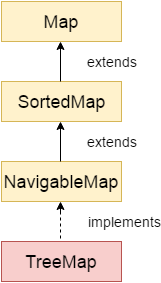Table of Contents
1. Đặc điểm
Những điểm quan trọng về lớp TreeMap trong java cần nhớ là:
- TreeMap lưu trữ dữ liệu dưới dạng cặp key và value.
- TreeMap chỉ chứa các key duy nhất.
- TreeMap KHÔNG cho phép bất kỳ key nào là null và nhưng có thể có nhiều giá trị null.
- TreeMap duy trì các phần tử được thêm vào theo thứ tự key tăng dần.
2. Hierarchy của lớp TreeMap

Lớp java.util.TreeMap được định nghĩa như sau:
public class TreeMap<K,V>
extends AbstractMap<K,V>
implements NavigableMap<K,V>, Cloneable, java.io.Serializable {
}
Trong đó:
- K: đây là kiểu key để lưu trữ.
- V: đây là kiểu giá trị được ánh xạ.
3. Các phương thức khởi tạo (constructor) của lớp TreeMap
- LinkedHashMap(): khởi tạo một map trống.
- LinkedHashMap(Map<? extends K, ? extends V> m): khởi tạo một map với các phần tử của map m.
4. Các phương thức (method) của lớp TreeMap
Xem thêm các phương thức của Map ở bài viết Map Interface trong java.
5. Ví dụ minh họa
5.1. Ví dụ sử dụng TreeMap với kiểu dữ liệu cơ bản (Wrapper)
package com.maixuanviet.collection.treemap;
import java.util.Map;
import java.util.Map.Entry;
import java.util.TreeMap;
public class LinkedHashMapExample {
public static void main(String args[]) {
// init map
Map<Integer, String> map = new TreeMap<Integer, String>();
map.put(1, "Basic java");
map.put(2, "OOP");
map.put(4, "Multi-Thread");
map.put(3, "Collection");
// show map using method keySet()
for (Integer key : map.keySet()) {
String value = map.get(key);
System.out.println(key + " = " + value);
}
System.out.println("---");
// show map using method keySet()
for (Entry<Integer, String> entry : map.entrySet()) {
Integer key = entry.getKey();
String value = entry.getValue();
System.out.println(key + " = " + value);
}
}
}
Kết quả thực thi chương trình trên:
1 = Basic java 2 = OOP 3 = Collection 4 = Multi-Thread --- 1 = Basic java 2 = OOP 3 = Collection 4 = Multi-Thread
5.2. Ví dụ sử dụng TreeMap với key có kiểu String, value có kiểu Student
package com.maixuanviet.collection.map;
public class Student {
private int id;
private String name;
public Student(int id, String name) {
this.id = id;
this.name = name;
}
@Override
public String toString() {
return "Student [id=" + id + ", name=" + name + "]";
}
public int getId() {
return id;
}
public String getName() {
return name;
}
}
package com.maixuanviet.collection.treemap;
import java.util.Map;
import java.util.Map.Entry;
import java.util.TreeMap;
public class LinkedHashMapExample2 {
public static void main(String args[]) {
// Student's data
Student student1 = new Student(1, "Student 1");
Student student2 = new Student(2, "Student 2");
Student student3 = new Student(3, "Student 3");
Student student4 = new Student(4, "Student 4");
// init map
Map<Integer, Student> map = new TreeMap<Integer, Student>();
map.put(student1.getId(), student1);
map.put(student2.getId(), student2);
map.put(student4.getId(), student4);
map.put(student3.getId(), student3);
// show map using method keySet()
for (Integer key : map.keySet()) {
Student value = map.get(key);
System.out.println(key + " = " + value);
}
System.out.println("---");
// show map using method keySet()
for (Entry<Integer, Student> entry : map.entrySet()) {
Integer key = entry.getKey();
Student value = entry.getValue();
System.out.println(key + " = " + value);
}
}
}
Kết quả thực thi chương trình trên:
1 = Student [id=1, name=Student 1] 2 = Student [id=2, name=Student 2] 3 = Student [id=3, name=Student 3] 4 = Student [id=4, name=Student 4] --- 1 = Student [id=1, name=Student 1] 2 = Student [id=2, name=Student 2] 3 = Student [id=3, name=Student 3] 4 = Student [id=4, name=Student 4]
Related posts:
Guide to the Synchronized Keyword in Java
Stack Memory and Heap Space in Java
Java Program to Repeatedly Search the Same Text (such as Bible by building a Data Structure)
Spring REST API + OAuth2 + Angular (using the Spring Security OAuth legacy stack)
Upload and Display Excel Files with Spring MVC
Java Program to Check if it is a Sparse Matrix
Check if a String is a Palindrome in Java
Java Program to Implement Rope
Lớp Collectors trong Java 8
Hướng dẫn Java Design Pattern – DAO
Apache Commons Collections BidiMap
Introduction to Eclipse Collections
Java Program to Implement Shell Sort
Converting Between an Array and a Set in Java
Java Program to Use the Bellman-Ford Algorithm to Find the Shortest Path
Spring MVC Setup with Kotlin
Java Program to Implement Fibonacci Heap
Java Program to Implement JobStateReasons API
Introduction to Spring Method Security
Java Program to Check whether Graph is a Bipartite using BFS
String Joiner trong Java 8
New Features in Java 15
Documenting a Spring REST API Using OpenAPI 3.0
Simple Single Sign-On with Spring Security OAuth2
Quản lý bộ nhớ trong Java với Heap Space vs Stack
Java – InputStream to Reader
Java Program to Solve a Matching Problem for a Given Specific Case
Introduction to Spring MVC HandlerInterceptor
Lớp Properties trong java
How to Find an Element in a List with Java
Adding Shutdown Hooks for JVM Applications
Java Program to Implement Affine Cipher

